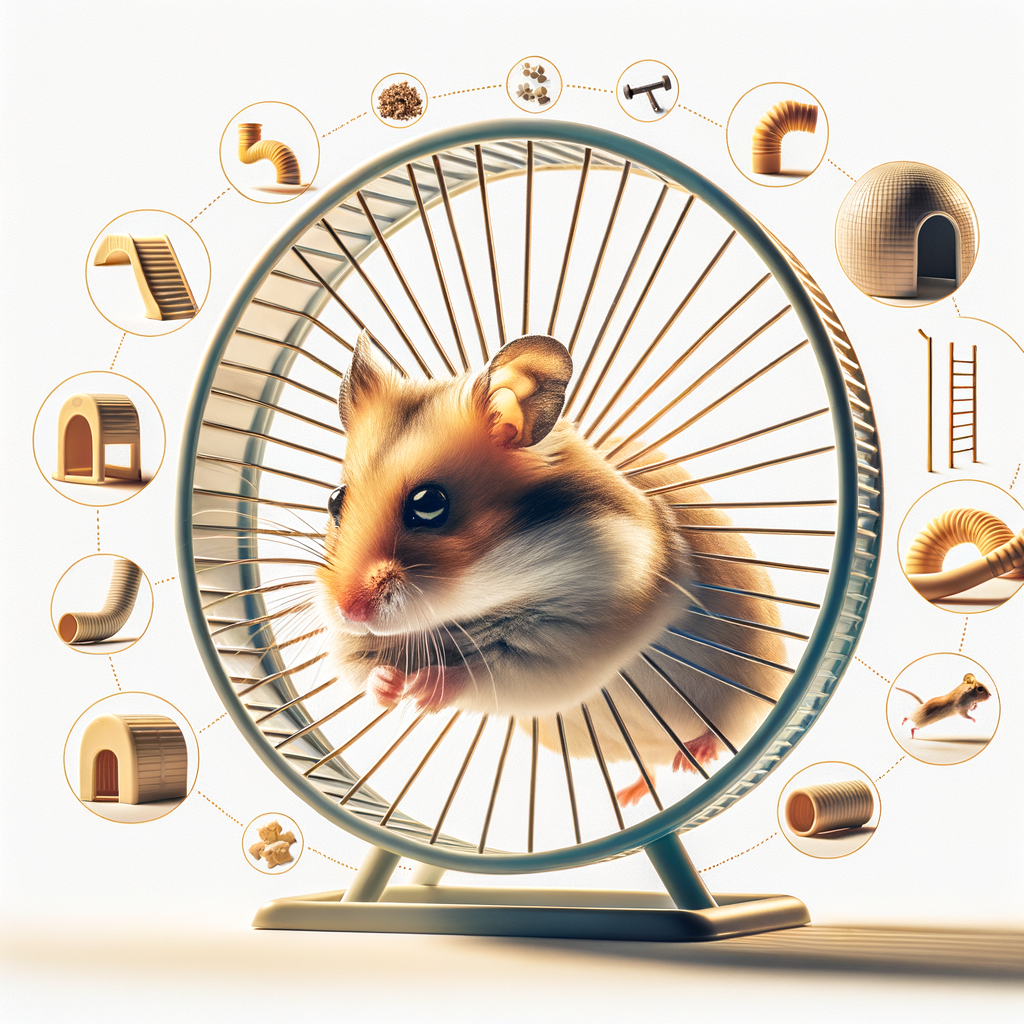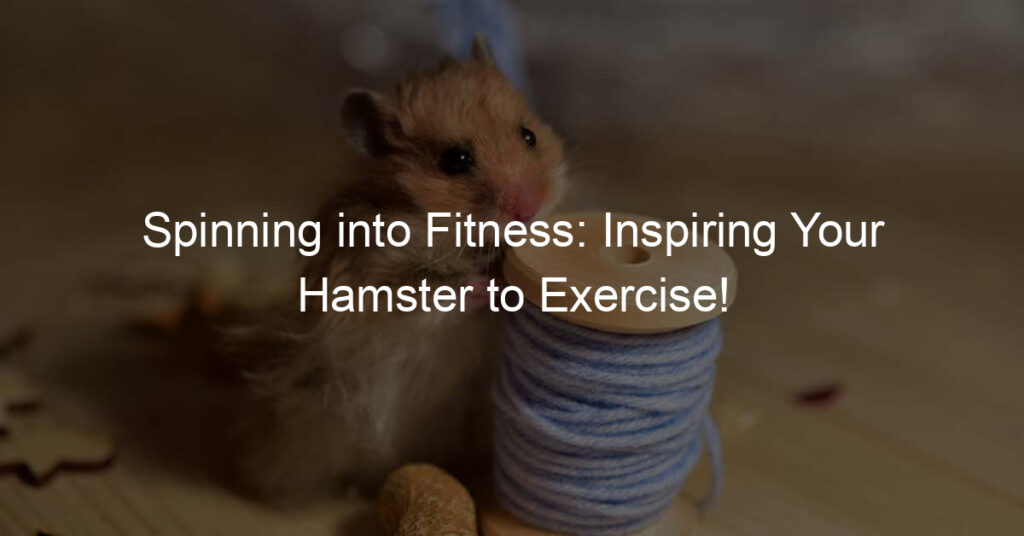
Introduction to Hamster Exercise
Exercise is a crucial part of every living creature’s life, and hamsters are no exception. In the wild, hamsters are active creatures, running miles every night in search of food. When we keep them as pets, it’s our responsibility to ensure they get the exercise they need to stay healthy and happy. This section will delve into the importance of exercise for hamsters and address some common misconceptions about hamster exercise.
- Importance of exercise for hamsters
- Common misconceptions about hamster exercise
Exercise is vital for a hamster’s physical and mental health. It helps them maintain a healthy weight, keeps their muscles strong, and prevents boredom and stress. A lack of exercise can lead to obesity and other health problems, such as heart disease and diabetes. Exercise also helps hamsters to burn off energy and stay mentally stimulated. Without enough exercise, hamsters can become stressed or depressed, which can lead to behavioral problems.
One common misconception is that hamsters don’t need much exercise because they’re small. In reality, hamsters are very active animals and need plenty of exercise to stay healthy. Another misconception is that a hamster wheel is enough for a hamster’s exercise needs. While a hamster wheel is an excellent tool for exercise, hamsters also need other forms of physical activity, like climbing and burrowing. Lastly, some people believe that hamsters should only exercise at night because they’re nocturnal. While it’s true that hamsters are most active at night, they can and should have access to exercise opportunities throughout the day.
Understanding the importance of exercise for hamsters and debunking common misconceptions is the first step towards ensuring your furry friend leads a healthy and active life. In the following sections, we will explore more about hamster exercise, including how to encourage your hamster to exercise and the role of a hamster wheel.
Hamster Exercise 101
Exercise is a fundamental aspect of a hamster’s life. It’s essential for their physical health and mental well-being. Let’s delve into understanding their exercise needs.
Understanding Hamster Exercise Needs
Just like humans, hamsters require regular exercise to stay healthy and happy. This exercise can come in many forms, from running on a wheel to exploring their environment. Let’s examine the benefits of exercise for hamsters.
- Physical benefits of hamster exercise
- Mental benefits of hamster exercise
Exercise helps hamsters maintain a healthy weight and promotes good digestion. It also strengthens their heart and lungs, reducing the risk of disease. Regular physical activity can even extend a hamster’s lifespan. A study showed that hamsters who exercised regularly lived longer than those who didn’t.
Exercise isn’t just about physical health; it’s also crucial for a hamster’s mental well-being. Hamsters are naturally curious and active creatures. Exercise provides them with the stimulation they need to stay mentally sharp. It helps reduce stress and prevents boredom, which can lead to destructive behaviors. A happy hamster is an active hamster!
In conclusion, understanding your hamster’s exercise needs is key to ensuring their overall health and happiness. By providing them with opportunities for physical activity and mental stimulation, you’re setting your furry friend up for a long, healthy, and joyful life.
Exercise for Hamsters: How Much is Enough?
One of the most important aspects of hamster care is ensuring they get enough exercise. But how much is enough? Let’s delve into the details.
- Recommended amount of daily exercise
- Signs your hamster may need more exercise
- Weight Gain: If your hamster is gaining weight, it might be a sign that they are not getting enough exercise.
- Restlessness: A hamster that is constantly trying to escape or is excessively active might be trying to tell you they need more exercise.
- Chewing on Cage: This could be a sign of boredom, which might mean your hamster needs more physical activity.
Hamsters are naturally active creatures, especially during the night. Experts recommend that hamsters should have at least one hour of exercise outside their cage each day. This can be achieved through a combination of running on their wheel, exploring in a hamster ball, or playing in a secure, hamster-safe area.
| Exercise Type | Duration |
|---|---|
| Wheel Running | 30 minutes |
| Hamster Ball Exploration | 15 minutes |
| Play in Hamster-Safe Area | 15 minutes |
Just like humans, hamsters can show signs when they are not getting enough exercise. These signs may include:
Remember, every hamster is unique and may require more or less exercise based on their age, health, and personality. Always monitor your hamster’s behavior and adjust their exercise routine as needed.
Encouraging Hamster Exercise
Hamsters are naturally active creatures that require regular exercise to maintain their health and happiness. Encouraging your hamster to exercise can be a fun and rewarding experience for both you and your furry friend. Let’s explore how to create a hamster-friendly exercise environment.
Creating a Hamster-Friendly Exercise Environment
Creating a suitable environment for your hamster to exercise is crucial. It involves choosing the right cage size and providing safe, stimulating toys. Let’s delve into these aspects.
- Choosing the right cage size
- Providing safe and stimulating toys
Size matters when it comes to your hamster’s cage. A small cage can restrict your hamster’s movement, leading to boredom and unhealthy weight gain. On the other hand, a large cage offers ample space for your hamster to run, climb, and play. As a rule of thumb, the minimum cage size for a hamster should be 450 square inches. However, bigger is always better. A spacious cage not only encourages exercise but also contributes to your hamster’s overall well-being.
Hamsters love to play! Providing a variety of safe and stimulating toys can encourage your hamster to be more active. Exercise wheels, tunnels, and climbing toys are excellent for keeping your hamster entertained and fit. Remember, the toys should be hamster-safe, meaning they should be free of small parts that your hamster could accidentally swallow. Also, ensure the toys are made of non-toxic materials. Regularly rotating the toys can also help keep your hamster’s interest piqued.
In conclusion, encouraging hamster exercise involves creating a conducive environment. This includes choosing a spacious cage and providing safe, stimulating toys. By doing so, you can ensure your hamster stays active, healthy, and happy.
Training Hamsters for Regular Exercise
Training your hamster to exercise regularly is a crucial part of their overall health and happiness. This process involves two key steps: introducing the exercise routine and maintaining consistency in the routine.
- Introducing the Exercise Routine
- Maintaining Consistency in the Routine
Introducing an exercise routine to your hamster is the first step towards ensuring their regular physical activity. Start by allowing your hamster to explore their new exercise wheel or toy. It’s important to remember that hamsters are nocturnal creatures, so they are more likely to exercise during the night.
Begin with short periods of exercise, gradually increasing the duration over time. For instance, you can start with 5 minutes of exercise and then add a minute each day until your hamster is comfortable with a 15-minute routine. This gradual introduction helps your hamster adjust to the new routine without feeling overwhelmed.
Maintaining consistency in your hamster’s exercise routine is just as important as introducing it. Consistency helps your hamster understand when it’s time to exercise, making the routine a regular part of their day.
Try to ensure that your hamster exercises at the same time each day. This consistency will help your hamster get into a routine, making it more likely they will exercise regularly. Remember, it’s essential to monitor your hamster during their exercise time to ensure they are safe and enjoying their activity.
In conclusion, training your hamster for regular exercise involves a careful introduction of the routine and maintaining consistency. By following these steps, you can ensure your hamster stays active, healthy, and happy.
Hamster Wheel 101
One of the most essential pieces of equipment for a hamster’s health and happiness is a hamster wheel. This simple device provides your furry friend with a fun and effective way to exercise. Let’s delve into the world of hamster wheels and learn how to train your hamster to use one.
Hamster Wheel Training: A Step-by-Step Guide
Training your hamster to use a wheel may seem challenging, but with patience and the right approach, it can be a smooth process. Here’s a step-by-step guide to help you through it.
- Choosing the right hamster wheel
- Introducing your hamster to the wheel
- Encouraging regular use of the wheel
Not all hamster wheels are created equal. The size of the wheel should be appropriate for your hamster’s size. A wheel that’s too small can cause back problems for your pet. Also, choose a wheel with a solid surface to prevent injuries to your hamster’s tiny feet.
Place the wheel in your hamster’s cage and let them explore it on their own. Hamsters are curious creatures and will likely investigate the new addition to their home. Don’t force your hamster onto the wheel; they need to feel safe and comfortable with it first.
Once your hamster has become familiar with the wheel, you can encourage regular use. Place treats on the wheel or use it during playtime. Remember, it’s important for your hamster to exercise daily, but don’t force them to use the wheel if they don’t want to.
With the right wheel and a little patience, your hamster will be running happily in no time. Remember, a healthy hamster is a happy hamster!
Hamster Wheel Exercise: Tips and Tricks
Hamster wheel exercise is a crucial part of your pet’s daily routine. It helps keep your hamster healthy, happy, and active. Here are some tips and tricks to ensure your hamster’s safety and monitor its wheel use effectively.
- Ensuring your hamster’s safety on the wheel
Hamster wheel safety is paramount. The wheel should be solid, without any gaps where your hamster’s tiny feet could get stuck. Also, the wheel should be large enough so that your hamster’s back remains straight while running. This prevents potential spinal injuries. Always check the wheel for any damage before letting your hamster use it.
- Monitoring your hamster’s wheel use
Observing your hamster’s wheel use can give you insights into its health and happiness. Hamsters typically run several miles each night. If your hamster is using the wheel less often or seems to be struggling, it might be a sign of health issues. Remember, too much of a good thing can also be harmful. If your hamster seems to be running excessively, it might be stressed or bored. Try introducing new toys or changing the cage layout to keep your hamster engaged.
| Hamster Wheel Safety Checklist |
|---|
| 1. Solid wheel with no gaps |
| 2. Appropriate wheel size |
| 3. Regular wheel checks for damage |
Remember, a healthy hamster is an active hamster. By ensuring your hamster’s safety on the wheel and monitoring its use, you can contribute to your pet’s overall well-being.
Healthy Hamster Habits
When it comes to maintaining a healthy lifestyle for your hamster, it’s not just about exercise. A balanced diet plays a significant role too. Let’s dive into how you can combine exercise with a balanced diet to ensure your hamster stays fit and healthy.
Combining Exercise with a Balanced Diet
Just like us, hamsters need a combination of good nutrition and regular exercise to stay healthy. Here’s how you can ensure your hamster gets the right balance.
- Understanding hamster nutrition
- How exercise and diet work together
Hamsters are omnivores, which means they eat both plants and meat. A balanced diet for a hamster includes a mix of fruits, vegetables, grains, and a small amount of protein. It’s important to avoid feeding your hamster too many sugary or fatty foods, as this can lead to obesity and other health problems.
Exercise and diet are two sides of the same coin when it comes to your hamster’s health. Regular exercise helps your hamster burn off the energy it gets from food, keeping its weight in check. On the other hand, a balanced diet provides the nutrients your hamster needs to stay active and healthy. So, make sure your hamster gets plenty of exercise and eats a balanced diet to stay in top shape.
Remember, every hamster is unique and may have different dietary needs and exercise preferences. Always observe your pet’s behavior and adjust their diet and exercise routine as needed. And, of course, regular check-ups with the vet are essential to keep your hamster healthy and happy.
Importance of Regular Vet Check-ups
Just like humans, hamsters also need regular check-ups to ensure they are in the best of health. These check-ups can help identify any potential health issues early, allowing for timely treatment and prevention. Let’s delve into why regular vet check-ups are so crucial for your hamster’s health.
- How vets can assess your hamster’s health
- Common health issues in hamsters
Veterinarians are skilled professionals who can thoroughly assess your hamster’s health. They will typically start with a general examination, checking your hamster’s weight, fur, eyes, ears, and teeth. They may also listen to your hamster’s heart and lungs to ensure they are functioning correctly.
Furthermore, vets can perform specific tests if needed. For instance, they might take a stool sample to check for parasites or conduct a blood test to detect any underlying diseases. Regular vet visits can help ensure your hamster is healthy and happy.
Hamsters, like other pets, can suffer from various health issues. Some of the most common ones include respiratory infections, diarrhea, tumors, and dental problems. Let’s take a closer look at these:
| Health Issue | Description |
|---|---|
| Respiratory Infections | These are often caused by bacteria and can lead to symptoms like sneezing, wheezing, and discharge from the eyes or nose. |
| Diarrhea | This can be a sign of a dietary issue or a more serious condition like wet tail, a potentially fatal disease in hamsters. |
| Tumors | Hamsters can develop tumors, both benign and malignant. Regular vet check-ups can help detect these early. |
| Dental Problems | Hamsters’ teeth continually grow, and if they don’t wear down properly, it can lead to dental issues. |
Regular vet check-ups can help detect these common health issues early, improving the chances of successful treatment and recovery.
In conclusion, regular vet check-ups are an essential part of keeping your hamster healthy. They can help detect health issues early and ensure your hamster is living its best life. So, remember to schedule regular vet visits for your furry friend!
Hamster Care Beyond Exercise
While exercise is a crucial aspect of hamster care, understanding your hamster’s behaviour is equally important. It helps you build a stronger bond with your pet and ensures their well-being.
Understanding Hamster Behaviour
Hamsters have a unique way of communicating their feelings and needs. By observing their behaviour, you can understand what they are trying to convey and respond appropriately. Let’s explore some common hamster behaviours and how you can respond to them.
- Common hamster behaviours and what they mean
- How to respond to your hamster’s behaviour
Hamsters exhibit a range of behaviours that can tell you a lot about their mood and health. For instance, if your hamster is gnawing on the bars of their cage, it could mean they are bored or stressed. On the other hand, a hamster that is grooming itself frequently is a sign of a content and healthy pet. It’s important to observe these behaviours closely to understand your hamster’s needs.
Once you understand what your hamster’s behaviours mean, you can respond in ways that ensure their happiness and health. If your hamster seems bored or stressed, try introducing new toys or changing their environment. If they are grooming themselves regularly, it’s a sign they are comfortable and you should continue with your current care routine.
Remember, every hamster is unique and may display behaviours differently. The key is to spend time with your pet, observe them closely, and respond with love and care.
Building a Bond with Your Hamster
Creating a strong bond with your hamster is an essential part of pet ownership. This bond not only enhances your relationship with your pet but also contributes to the overall health and happiness of your hamster. Let’s explore the importance of social interaction and some tips for bonding with your hamster.
- Importance of Social Interaction
- Tips for Bonding with Your Hamster
- Handle with Care: Hamsters are delicate creatures. Always handle your hamster gently and with care. This will help them to feel safe and secure with you.
- Play Time: Hamsters are active and playful creatures. Dedicate some time each day to play with your hamster. This will not only keep them physically active but also mentally stimulated.
- Feeding Time: Feeding time is a great opportunity to bond with your hamster. Offering treats from your hand can help to build trust.
- Patience is Key: Remember, building a bond takes time. Be patient and consistent in your interactions with your hamster.
Hamsters, like humans, are social creatures. They thrive on interaction and companionship. Lack of social interaction can lead to loneliness and depression in hamsters, affecting their health and lifespan. Regular interaction with your hamster helps them to feel secure and loved, and it also allows you to monitor their health closely.
Bonding with your hamster can be a rewarding experience. Here are some tips to help you build a strong bond with your furry friend:
In conclusion, building a bond with your hamster is a rewarding experience that benefits both you and your pet. Regular social interaction and gentle handling are key to creating a strong bond. Remember, patience and consistency are crucial in this process.
Conclusion: The Joy of a Healthy, Active Hamster
As we wrap up our discussion on hamster exercise and care, let’s take a moment to appreciate the joy that a healthy, active hamster brings into our lives. These little creatures, with their boundless energy and curious nature, not only make wonderful pets but also teach us valuable lessons about the importance of regular exercise and proper care.
- Recap of Key Points
- Final Thoughts on Hamster Exercise and Care
We’ve learned that exercise is crucial for a hamster’s health and well-being. Hamsters are naturally active creatures that require plenty of physical activity to stay healthy and happy. We’ve also discovered that a hamster wheel is an essential piece of equipment for any hamster owner, providing a safe and convenient way for hamsters to get their daily exercise.
Moreover, we’ve discussed the importance of encouraging hamster exercise and establishing healthy habits. This includes providing a variety of toys and activities, maintaining a clean and comfortable habitat, and offering a balanced diet.
Finally, we’ve explored hamster care beyond exercise, emphasizing the importance of regular vet check-ups, proper grooming, and careful handling.
Hamster exercise and care go hand in hand. A well-exercised hamster is a healthy hamster, and a healthy hamster is a happy hamster. As hamster owners, it’s our responsibility to provide our pets with the care they need to thrive. This includes not only ensuring they get plenty of exercise, but also providing them with a balanced diet, a clean habitat, and regular vet check-ups.
Remember, a healthy, active hamster is a joy to behold. So let’s do our best to keep our furry friends healthy, active, and happy!








